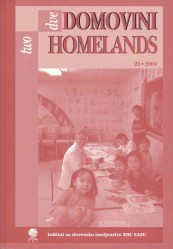TRANSFORMATION OF ETHNICITY: MOVE TO PUBLIC EXPRESSING SYMBOLIC ETHNIC IDENTITY
Abstract
With children of Slovene emigrants in Australia who came to the south continent mainly in the 50ies, 60ies and 70ies of the 20th century, we can follow a dynamic sensation of appurtenance, which is not unchangeably liable to certain patterns of the culture but can successfully steer between different aspects of that culture and among cultures themselves. In Australian society, already with the second generation Slovene ethnicity exhibits as flexible, symbolic and voluntary. On the one hand, it is still based on their personal experiences connected with primary families and with the past, and on the other that same generation is experiencing ethnicity on another level, which frequently includes in public image of individuals. Identification with a certain ethnic group became in modern society at least fictive if not realistic a surety of broader understandings and global aspects. The media as well of the majority as the minority - ethnic, frequently influence on such a conviction as they bring it into public sphere. Ethnic media are active upon a much smaller population yet they reinforce ethnic identity in many ethnic groups and build public image of individual cultures. In the past, of ethnic programmes, radio ones were of greater importance. Today it seems their position is taken over by newer media.
One of many ethnic groups that create their own ethnic programme on two radio stations in Melbourne in Australia, the SBS and 3YYY, is the Slovene. The Slovene ethnic radio media serves almost exclusively the Slovene emigrants of the first generation and therefore does not include members of the second and third generations that at least partially identify themselves with this ethnicity. The characteristics of the Slovene programme are linked to physical proximity and to stereotype, traditional forms. As such, the Slovene ethnic radio programme does not influence in a larger proportion on forming or preserving ethnic identity of the second and next generations. The internet could offer a new and somewhat different a dynamics in the Slovene community in Australia, especially with ethnically coloured web sites of Thezaurus that Slovenes in Melbourne create. Web pages create new space for communication, interaction and debate (with discussion forums). Yet it is for people of Slovene descent in Australia almost impossible to predict whether ethnically aware individuals will use the internet as a principal field for reinforcement of their multiple ethnic identities. Such web sites can become an interactive canal for acquiring complex information on Slovene culture, on the basis of which the younger generations form their opinion on it and thus choose and define their own ethnic identity.
Downloads
References
A lba, Richard (1990): Ethnic Identity: The Transformation o f W hite America. New Haven, New York: Yale University Press.
Anthias, Floya (200 1), New hybridities, old concepts: the limits o f ‘culture’, Ethnic and Racial Studies, 24, 4, str. 619-641.
Ceferin, Aleksandra (2003): Slovenian Language in Australia: 25 vears o f Slovenian Language in Victorian Schools: Institute for Slovenian Studies ofV ictoria 1977¬ 2002. Clayton North: Institute for Slovenian Studies o f Victoria.
Elkins, David J. (1997), Globalization, Telecomunication and Virtual Ethnic Communities, International Political Science Review, 18, 2, 139-152.
Elkins, David J. (1999), Think Locally, Act Globally: Reflections on Virtual N eighbourhoods, Javnost/The Public, 6, 1, 37-54.
G ans, Herbert J. (1979), Sym bolic Ethnicity: the Future ofE thnic Groups and Cultures in America, E thnic andR acialStudies, 1, 1, str. 1-20.
Gans, Herbert J. (1994), Symbolic Ethnicity and Symbolic Religiosity: Towards a Comparison o f Ethnic and Religious Acculturation, Ethnic and Racial Studies, 17,4, str. 557-592.
Glazer, Nathan in M oynihan, Daniel P. (1996), “Beyond the M elting Pot”, Ethnicity (uredila John Hutchinson in Anthony D. Smith, New York, Oxford: Oxford University Press, str. 135-138.
Hall, Stuart (1997), “Introduction. Who needs Identity?”, Questions o f Cultural Identity (uredila Stuart Hall in Paul Du Gay), London, Thousand Oaks, New Delhi: Sage Publications, str. 117.
Hutchinson, John (1996), “Ethnicity and M ulticulturalism in Immigrant Societies”, Ethnicity (uredila John Hutchinson in Anthony D. Smith, New York, Oxford: Oxford University Press, str. 374-378.
Hutchinson, John (2000), Ethnicity and modem nations, Ethnic and Racial Studies, 2 3 ,4 , str. 651-669.
Južnič, Stane (1993): Identiteta. Ljubljana: Fakulteta za družbene vede.
Lukšič Hacin, M arina (1999): M ultikulturalizem in migracije. Ljubljana: Založba ZRC.
M allapragada, M adhavi (2000), “The Indian Diaspora in the USA and around the Web”, Web, Studies: Rewriting M edia Studies fo r the Digital Age (uredil David Gauntlett), London: Arnold, str. 179-185.
Mlinar, Zdravko (1994): Individuacija in globalizacija vprostoru, Ljubljana: SAZU.
Poole, Elizabeth (2002), Networking Islam: The Democratising potential ofnew Technologies in relation to M uslim Communities, Javnosti The public, 9, 1, str. 51-64.
Rheingold, H ow ard (2000), “Com munity Development in the Cybersociety o f the Future”. Web. Studies: Rewriting M edia Studies fo r the D igital Age (uredil David Gauntlett), London: Arnold, str. 170-179.
Skrbiš, Zlatko (1999): Long-distance Nationalism: Diapsoras, Homelands andldentities, Aldershot: Ashage.
Skrbiš, Zlatko (2003), Diasporično slovenstvo: politika, nacionalizem in mobilnost, D ružboslovne razprave, 19, 42, str. 9-20.
Waters, Mary C. (1990): Ethnic option; Choosing Identities in America. Berkley, Los Angeles, Oxford: University of California press.
Young, Robert (1996): Colonial Desire: Hybridity in Theory, Culture and Race, London: Routledge.
Downloads
Published
How to Cite
Issue
Section
License

This work is licensed under a Creative Commons Attribution-NonCommercial-NoDerivatives 4.0 International License.
Authors guarantee that the work is their own original creation and does not infringe any statutory or common-law copyright or any proprietary right of any third party. In case of claims by third parties, authors commit their self to defend the interests of the publisher, and shall cover any potential costs.
More in: Submission chapter





